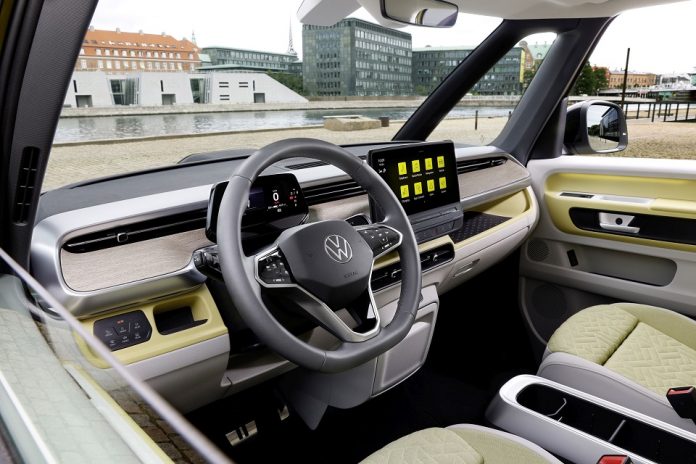Steering wheel covers made from non-animal leather, seat finishes made from cellulose or recycled materials made from plastic bottles: to further advance the production of its vehicles when it comes to sustainability, Volkswagen is aiming to further reduce the ecological footprint in the all-electric ID. family. VW is researching various promising approaches and implementing them in series production. One focus area is using non-animal and recycled materials in the interior.
The well-established and often only alternative to date was imitation leather, which is predominantly based on plastics made of mineral oil, such as polyurethane or PVC. So, during a brainstorming session held by the team for biomaterials at Volkswagen Group Innovation, the idea of coffee leather was formed, since when the beans are roasted, the silver skin surrounding the coffee bean ends up being a residual material. The silver skins are a perfect filler for imitation leather. The substance builds up dried, and in a format very well suited for further processing.
The non-animal imitation leather with its high proportion of biological materials could soon be used for car seats and arm rests in prototypes. “There is huge potential, and this could be one of the next steps for further optimising the ecological footprint of our ID. electric fleet,” says Dr. Martina Gottschling, a Volkswagen Group Innovation researcher.
Volkswagen already uses many innovative materials in the interior of the ID. Buzz, and now these will be gradually introduced to the other models in the ID. family. For example, alternative materials made from marine plastic or old plastic bottles (63 half-litre bottles to be precise) are used widely in the new “Bulli’s” interior. The upper material of a seat cover is made from Seaqual® yarn, which consists of collected marine debris (10 percent) and recycled PES yarn (90 percent). This reduces carbon emissions by 32 percent in the manufacturing process, compared with conventional surface materials. 71 percent of the materials of seat covers made from ArtVelours Eco® are recycled.
In addition, the finishes on the roof linings and carpet in the ID. Buzz are made from 100 percent recycled polyester. The insulating layer of the carpet also contains recycled plastics. As do components such as the underbody panelling and the wheel housing liners. It is important to note that each recycled material must meet the same high quality and value criteria as new material.
Furthermore, Volkswagen no longer uses chrome for decorative parts on the doors, dashboard, or steering wheel clasp of the ID. Buzz, due to the environmental impact of manufacturing this metal. It has been replaced with a chrome-look liquid paint that has a bio-based binding agent.
And the search for new, sustainable materials continues: at the Open Hybrid LabFactory (OHLF) on the outskirts of Wolfsburg, Volkswagen is researching alternative materials for automotive engineering. To improve the environmental balance of electric cars in the process, the circular economy is an increasingly important factor – this includes developing plastics from recycled materials and using natural materials in biological cycles.
Dr. Marko Gernuks is the Volkswagen representative on the OHLF board of management and says: “We want to shape processes, materials and components in such a way that they make substantial improvements to the circular economy. To do so, we are planning to develop new plastics from recycled materials. We want to automate disassembly processes to separate materials economically, and we are choosing natural materials in biological cycles.”
One approach that Volkswagen researchers feel has huge potential is an increasing number of biomaterials. This is about much more than just industrial crops such as rapeseed or softwood – since these innovative materials can also be generated in the lab. For example, pure cellulose is being researched currently, which in its natural form can be found in the cell walls of plants, for example, in wood. In the lab, bacteria can generate this in a pure form. The natural polymer is very stable and resistant; it is also well suited to recycling processes in the car and can be composted.




